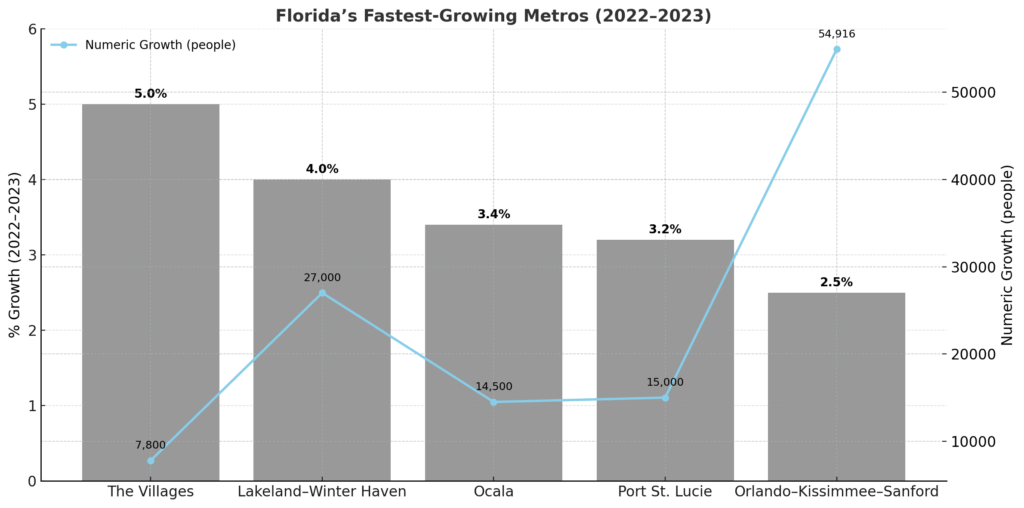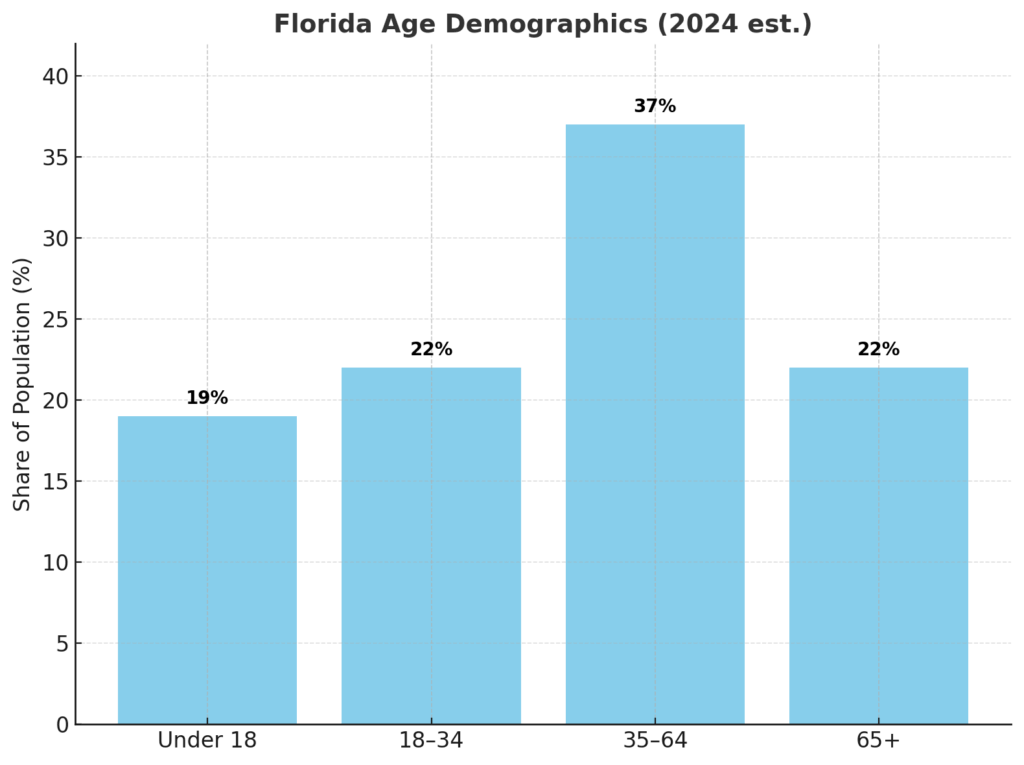Florida has grown very fast in recent years. From 2020 to 2024, the population rose by 8.24 percent, more than in any other state. That surge has already changed daily life in many parts of Florida.
More than 1.8 million people moved to the state in those four years, and 467,347 arrived in 2023 alone, according to Census.gov. Many newcomers came for lower living costs, steady work, and warm weather that allows outdoor life for most of the year.
Florida now has about 23.37 million residents, which places the state behind only California and Texas. While the United States as a whole grew by about 1.1 percent, the Sunshine State moved far ahead of that pace.
Population Growth of Florida Compared to the National Average

Florida attracts a volume of new residents that sets a different pace from other fast growing states such as Texas, Idaho, and Nevada. Each state shows strong upward movement, and Florida moves at a level that combines rapid percentage gain with very large raw numbers in a way no other entry on the list reaches.
State Population Growth Rates (2020–2024)
| State | % Growth | Numeric Growth | 2024 Population (est.) |
| Florida | +8.24 percent | +1.8 million | 23.37 million |
| Idaho | +8.23 percent | +32111 | 1.07 million |
| Texas | +6.7 percent | +2.0 million | 31.5 million |
| Nevada | +5.9 percent | +182000 | 3.26 million |
| United States average | +1.1 percent | +1.6 million | 335 million |
Florida stands out by pairing a high percentage increase, similar to Idaho, with the kind of raw population gain seen in Texas.
Our colleagues at NCH Stats made a more detailed overview of the population of Florida, so check it out.
Migration as a Force That is Reshaping Florida
Domestic Migration
Florida holds a steady lead as the top destination for Americans moving across state lines. The New York Times notes that net migration in 2022 added 249,064 new residents, a figure far above any other state.
Net flow eased in 2023 to 126008, yet Florida remained in the lead by a wide margin.
Arrivals come from a predictable group of states, each with clear reasons behind the move:
- New York and New Jersey: high taxes, steep housing costs, and long winters push many households toward a warmer and less costly option.
- California: rapid price climbs in major metros send families and retirees east toward a more stable cost structure.
- Midwestern states (Illinois, Ohio, Michigan): residents aim for warmer climates and tax setups that work better for retirement income.
International Migration
Florida holds a long record as a major entry point for global arrivals.
Roughly 21 percent of the state population is foreign-born, and that share places Florida near the top nationwide.
Miami remains a central arrival point for Latin American and Caribbean communities, and cities such as Orlando, Tampa, and Jacksonville show steady growth in their own immigrant populations.
International migrants add far more than population numbers. They supply labor across tourism, construction, healthcare, and a wide range of small trades. Many open new businesses that anchor neighborhoods and lift local markets, and many settle in regions that seek steady workforce growth.
The overall effect strengthens both economic output and daily life across the state.
Why People Choose Florida?
View this post on Instagram
Florida stands out as one of nine states without an income tax.
The absence of estate and inheritance taxes adds further appeal, especially for retirees and high-net-worth households focused on long-term asset preservation for future generations.
2. Climate and Lifestyle
Year-round sun, long stretches of coastline, golf resorts, and major recreation hubs such as Disney World and The Villages draw steady interest from families and retirees.
Humid summers and hurricane exposure remain part of the tradeoff, yet the overall climate advantage continues to pull residents from colder regions seeking a warmer and more active setting.
3. Economic Opportunity
Florida holds a GDP above 1.7 trillion dollars, large enough to rank among the world’s major economies on its own.
Key sectors show a wide range and steady expansion, supported by tourism, healthcare, financial services, aviation, aerospace, and major port systems in Miami, Jacksonville, and Tampa.
- Tourism and hospitality
- Healthcare
- Aviation and aerospace
- Financial services
- Logistics and port activity in Miami, Jacksonville, and Tampa
Remote work patterns and corporate moves from northern and western regions added another layer of momentum, creating new hiring streams and a broader mix of employers across the state.
Metro Area Growth
Population gains do not fall evenly across the state. Some metro areas expand at a pace that reshapes entire regions, while others move forward at a steadier rate.
The overall comparison shows sharp contrasts between retirement centers, business hubs, and inland communities now pulling in new arrivals.
Florida’s Fastest-Growing Metros (2022–2023)

The mix of retirement centers such as The Villages and Port St Lucie, alongside younger and rapidly expanding metros such as Orlando and Tampa, shows how wide the popularity has become.
The range of age groups, backgrounds, and work patterns behind the trend gives Florida a broader base than many states with similar growth rates.
Some Cities Are Getting a Lot of People Pretty Fast
Recent numbers show a clear shift in the urban balance within the state. Jacksonville moved past the one million mark in 2024 and now stands as the largest city in Florida.
Housing costs, job access, and overall land availability support steady inflow and rising long-term demand.
Here Are Some Highlights
- Jacksonville crossed the 1 million population mark in 2024, overtaking Miami as the state’s largest city. Its relatively affordable housing and growing job base are key drivers.
- Orlando remains the fastest-growing large city, benefiting from tech, hospitality, and aerospace jobs.
- Tampa Bay is diversifying beyond tourism into finance and logistics.
- Smaller cities like Deltona, Plantation, and Sunrise recently surpassed 100,000 residents, showing growth spreading beyond just the traditional urban centers.
How Demographics Shape Life Across Florida
Many people repeat the idea of Florida as a retirement capital, and the state indeed holds a large share of older residents, yet the picture only covers part of the reality.
A wider look shows a population shaped by younger families, new workers, students, and long-term migrants who add energy and movement far beyond the familiar stereotype.
Florida Age Demographics (2024 est.)

As you can see in the chart, Florida is not just a retirement hub.
A significant share of young professionals and families are moving in, particularly to Central Florida metros.
The age mix explains why both suburban school districts and retirement communities are expanding simultaneously.
Projections
Florida is expected to add 1.4 million new residents by 2030, bringing the population close to 25 million, according to Florida Realtors.
However, growth is projected to moderate slightly due to rising housing and insurance costs.
Population Projections
| Year | Population (est.) | Net Daily Migration |
| 2024 | 23.37 million | 972 |
| 2025 | 23.6 million | ~910 |
| 2030 | 24.8 million | ~789 |
Even with moderation, this is far ahead of the U.S. average, where some states (like Illinois and West Virginia) are actually losing population.
Boomtown Florida – A Southern Surge
A recent study by LendingTree reveals that eight of the top ten fastest-growing U.S. metropolitan areas are in the South, with five located in Florida: Orlando (2nd), North Port, Cape Coral, Lakeland, and Deltona.
Florida stands as a major driver of growth across the region, powered by lower taxes, accessible housing, steady job creation, and education-to-career paths that bring in younger residents and keep longtime households rooted in the state.
The Housing Backlash – Boom Meets Burden
Florida saw sharp price jumps after the pandemic, yet newer data shows the market turning. Overbuilding in several metros, rising insurance costs, higher HOA fees, and heavier property taxes now push monthly expenses upward and cut deep into affordability.
Business Insider reports that the strain has reached a point where some residents look to Tennessee, Georgia, and other nearby states for lower overall costs and fewer financial risks.
Population Growth Spurs Political Moves

Governor Ron DeSantis and House Speaker Daniel Perez use Florida population gains as support for a mid-decade redistricting push, a move critics argue could tilt representation in their favor.
Rising interest inside the GOP adds momentum to that plan, as Axios reports a wider effort to reshape districts in fast-growth states before the 2026 elections.
Population Movement Toward the South
The US population shows a strong shift toward the South, driven by housing costs, tax rules, and wider use of remote work across many fields.
In 2022, the South added over one million more residents than all other regions combined, with Florida at the front, along with Texas, North Carolina, and Georgia.
Pressure Points That Come With Rapid Growth
Florida expansion carries clear risks that shape daily life and long-term planning across the state. Several issues now stand out as the main limits on sustained population momentum:
- Housing affordability: Median home prices in Miami and Tampa climbed close to seventy percent since 2020, pushing many middle-income households out of reach of stable ownership.
- Insurance pressure: Home insurance premiums rose 42.5 percent from 2020 to 2024, adding a large recurring cost that can slow new arrivals and strain longtime residents.
- Climate exposure: Higher sea levels and stronger storms create long-range risks for coastal counties and threaten home values and public planning strategies.
- Infrastructure load: Roads, schools, hospitals, and power systems face heavy strain, especially across Central and South Florida, where population gains remain strongest.
Conclusion
Florida is now the nation’s third-most-populous state, with 22.6 million residents. Miami-Dade accounts for about 2.7 million of those residents, or about 12% of Florida’s population. https://t.co/5G06lkQRgA
— U.S. News & World Report (@usnews) April 17, 2024
The population of Florida rises due to several forces that work together in a steady and visible way, including large migration waves, wide job access across major metros, tax relief, coastal lifestyle appeal, and an age mix far broader than many people expect.
The southern East Coast state draws newcomers from many regions and many stages of life, which creates momentum that few other states can match.
- Retirees drawn to warm weather and lower overall tax pressure
- Younger workers who build careers in Orlando, Tampa, and Jacksonville
- International arrivals who add energy to culture and small business growth
The Sunshine State faces rising home costs, heavy insurance pressure, and clear climate risks along the coast, yet the population continues to grow at a pace that stands ahead of every large state.
Florida now sits at the heart of the United States population change, with growth strong enough to shape national trends through 2025 and well beyond 2035.


